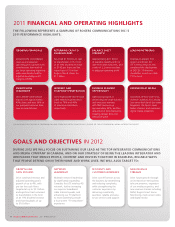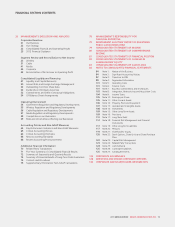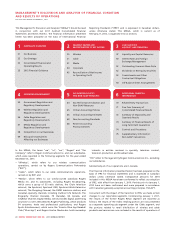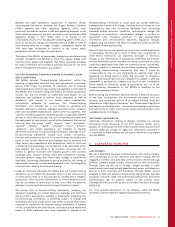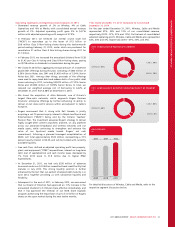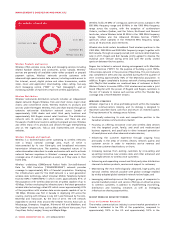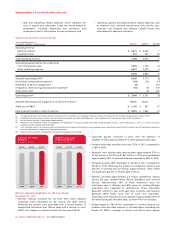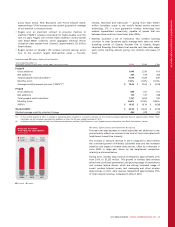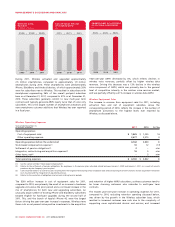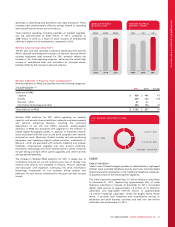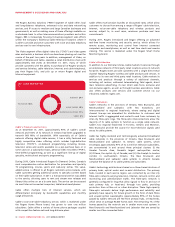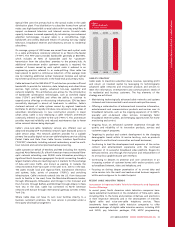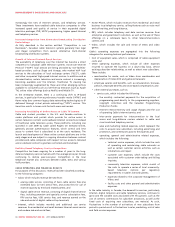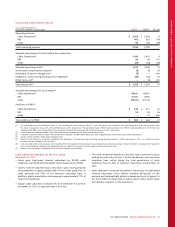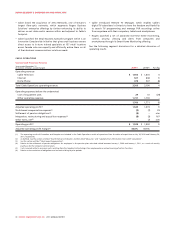Rogers 2011 Annual Report Download - page 31
Download and view the complete annual report
Please find page 31 of the 2011 Rogers annual report below. You can navigate through the pages in the report by either clicking on the pages listed below, or by using the keyword search tool below to find specific information within the annual report.
MANAGEMENT’S DISCUSSION AND ANALYSIS
United Kingdom, and Wireless expects the Canadian wireless industry
to continue to grow by approximately 4 percentage points of
penetration over the next several years. As penetration deepens, it
requires an increasing focus on customer satisfaction, the promotion
of new data and voice services to existing customers, and customer
retention.
Demand for Sophisticated Data Applications
The ongoing development of wireless data transmission technologies,
such as handsets and portable computing devices, has led wireless
device developers to develop more sophisticated smartphone type
devices with increasingly advanced capabilities, including access to
e-mail and other corporate information technology platforms, news,
sports, financial information and services, shopping services, photos,
music, applications, and streaming video clips, mobile television and
other functions. Wireless believes that the introduction of such new
devices and applications will continue to drive growth of wireless
data services.
Convergence of Technologies
Technologies across different platforms have been converging over
the past few years, and examples of such applications have been
proliferating across the industry. Wireless launched several such
applications in the market place, including a remote digital cable
terminal control application, where the user can manage their
recordings on the terminal from a smartphone or a tablet, and a live
TV content streaming application to smartphones and tablets.
Increased Competition from Other Wireless Operators
Wireless faces increased competition from incumbent wireless
operators as well as new entrants in the wireless market, which is fully
described in the section of this MD&A entitled “Competition in our
Businesses”. The new entrants have introduced new unlimited pricing
plans and extremely aggressive pricing and promotions which have
resulted in downward price adjustments and lower ARPU as well as
increases in customer churn for Wireless.
Migration to Next Generation Wireless Technology
The ongoing development of wireless data transmission technologies
and the increased demand for sophisticated wireless services,
especially data communications services, have led wireless providers
to migrate towards the next generation of digital voice and data
broadband wireless networks such as HSPA+ and LTE. These networks
are intended to provide wireless communications with wireline
quality sound, far higher data transmission speeds with increased
efficiency, and enhanced video streaming capabilities. These networks
support a variety of increasingly advanced data applications,
including broadband Internet access, multimedia services and
seamless access to corporate information systems, including desktop,
client and server-based applications that can be accessed on a local,
national or international basis. Wireless has been a leader in
deploying next generation technology with LTE. As at December 31,
2011, more than eight million Canadians already had access to Rogers’
LTE network, which will continue to expand during 2012.
Development of Additional Technologies
In addition to the two main technology paths of the mobile/
broadband wireless industry, namely GSM/HSPA and Code Division
Multiple Access/Evolution Data Optimized (“CDMA/EVDO”), the next
significant broadband wireless technology in deployment is LTE.
Wireless Interoperability for Microwave Access (“WiMAX”)
deployments have slowed down and several WiMAX operators have
announced plans to move over to LTE.
WiFi (the IEEE 802.11 industry standard) allows suitably equipped
devices, such as laptop computers and personal digital assistants, to
connect to a local area wireless access point. These access points
utilize unlicenced spectrum and the wireless connection is only
effective within a local area radius of approximately 50-100 metres of
the access point, and provide speeds similar to a wired local area
network (“LAN”) environment (most recently the version designated
as 802.11n). As the technology is primarily designed for in-building
wireless access, many access points must be deployed to cover the
selected local geographic area, and must also be interconnected with
a broadband network to supply the connectivity to the Internet.
Future enhancements to the range of WiFi service and the
networking of WiFi access points may provide additional
opportunities for wireless operators or municipal WiFi network
operators, each providing capacity and coverage under the
appropriate circumstances.
LTE, the worldwide GSM community’s new fourth generation (“4G”)
broadband wireless technology evolution path, is an all IP-based
wireless data technology based on a new modulation scheme
(orthogonal frequency-division multiplexing) that is specifically
designed to improve efficiency, lower costs, improve and expand the
range of voice and data services available via mobile broadband
wireless networks, make use of new spectrum allocations, and better
integrate with other open technology standards. As a 4G technology,
LTE is designed to build on and evolve the capabilities inherent in
UMTS/HSPA, which is the world standard for mobile broadband
wireless and standard upon which Wireless operates. LTE is fully
backwards compatible with UMTS/HSPA and is designed to provide
seamless voice and broadband data capabilities and data rates
capable of up to 150 Mbps. Wireless deployed and launched its LTE
network and services in 2011 as discussed above.
WIRELESS OPERATING AND FINANCIAL RESULTS
For purposes of this discussion, our Wireless segment revenue has
been classified according to the following categories:
• Network revenue, which includes revenue derived from:
• postpaid (voice and data services), which consist of revenues
generated principally from monthly fees, airtime, data usage,
long-distance charges, optional service charges, system access
and government cost recovery fees, and roaming charges; and
• prepaid (voice and data services), which consist of revenues
generated principally from airtime, data usage and other
ancillary charges such as long-distance and roaming.
• Equipment sales net of subsidies, which consist of revenue
generated from the sale, generally at or below our cost, of
hardware and accessories to independent dealers, agents and
retailers, and directly to subscribers through direct fulfillment by
Wireless’ customer service groups, websites and telesales.
Wireless’ operating expenses are segregated into the following
categories for assessing business performance:
• Cost of equipment sales, which is comprised of wireless equipment
costs; and
• Other operating expenses, which includes all other expenses
incurred to operate the business on a day-to-day basis, service
existing subscriber relationships, as well as attract new subscribers.
These include:
• employee salaries and benefits, such as remuneration, bonuses,
pension, employee benefits and stock-based compensation; and
• other external purchases, such as:
• service costs, including inter-carrier payments to roaming
partners and long-distance carriers, network service delivery
costs, and the Canadian Radio-television Telecommunications
Commission (“CRTC”) contribution levy;
2011 ANNUAL REPORT ROGERS COMMUNICATIONS INC. 27



